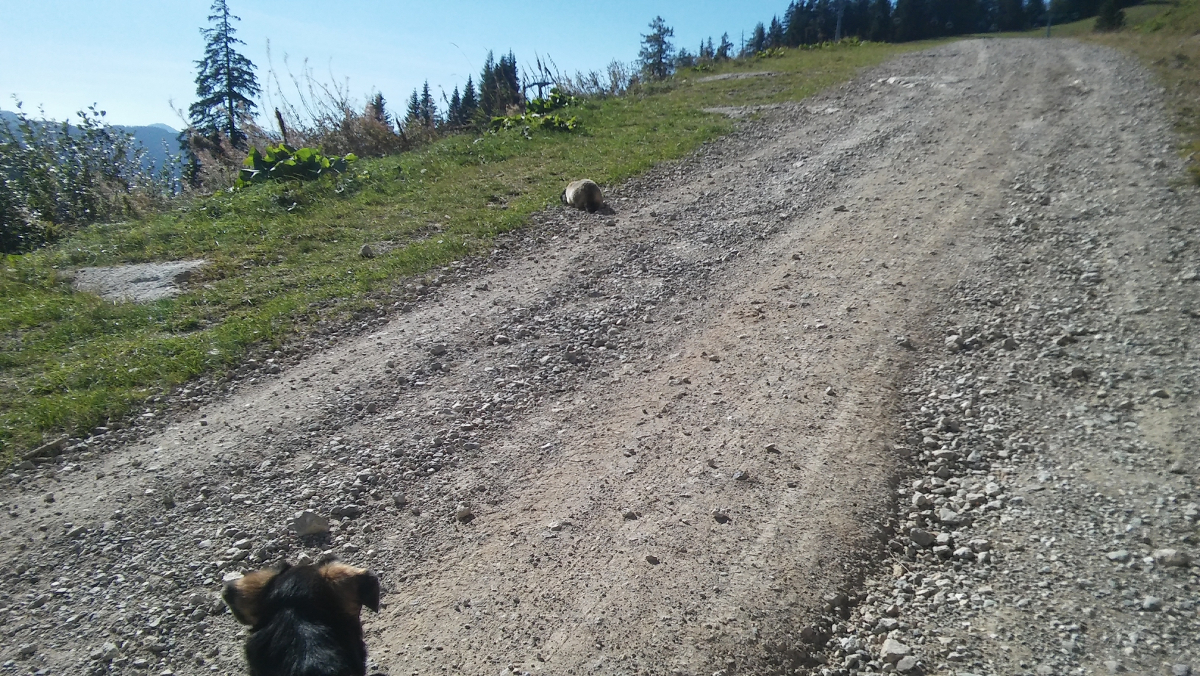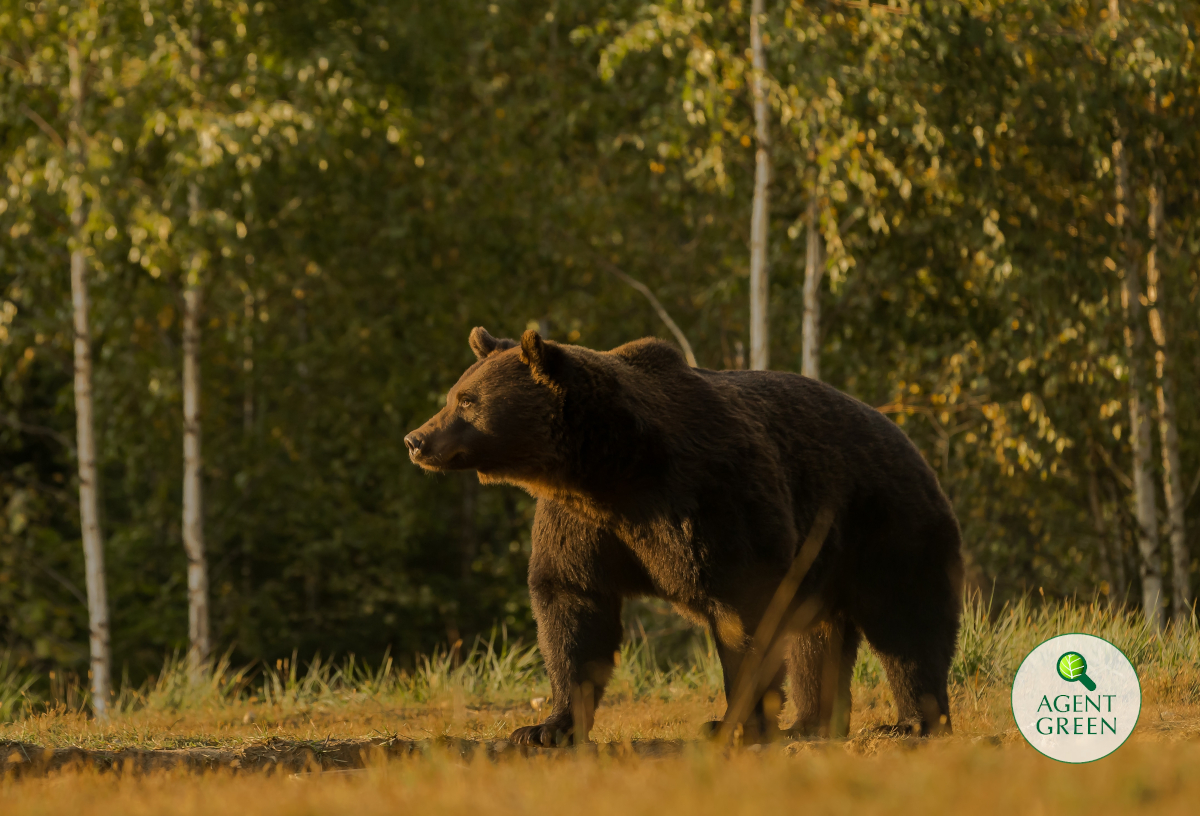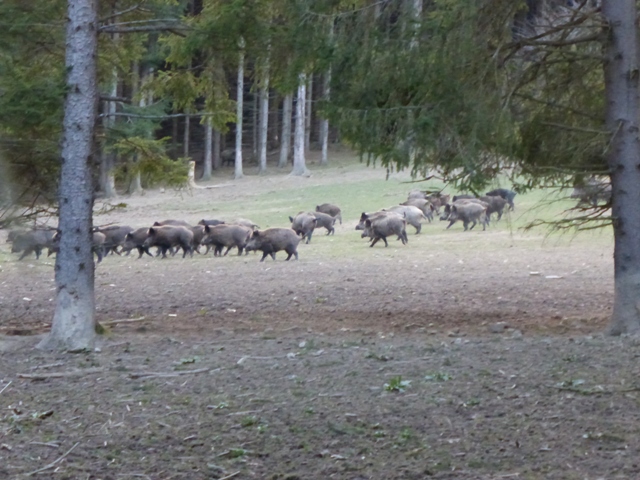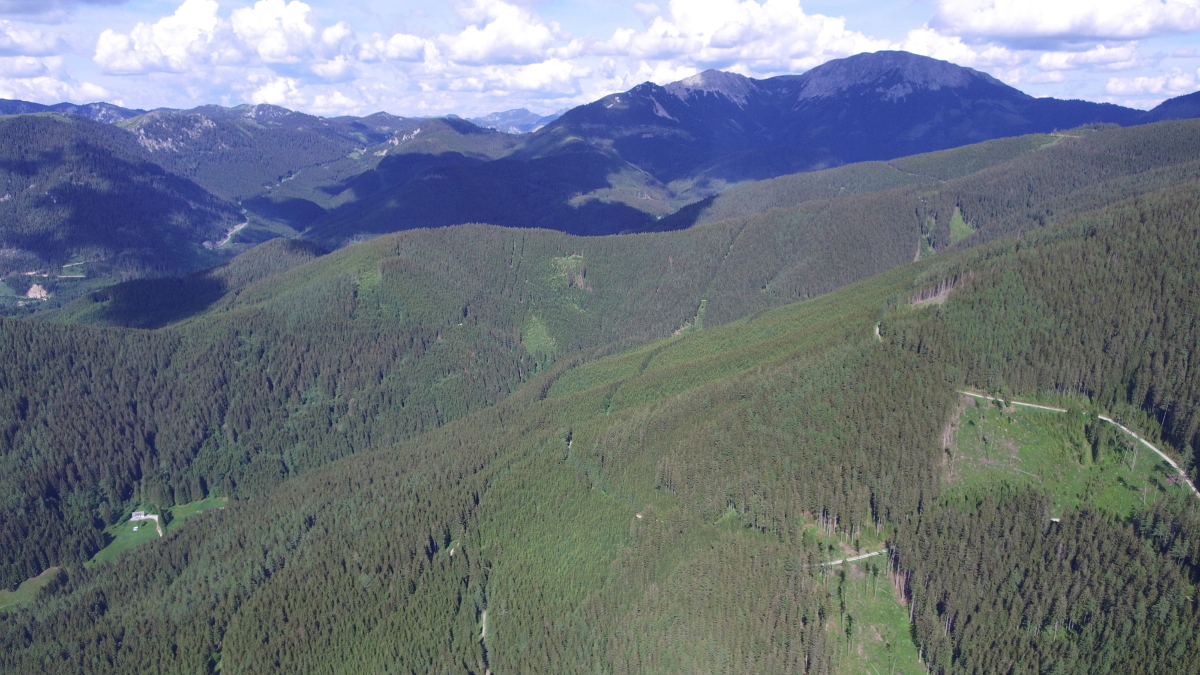Gerade von einer Woche im Wald zurück, wird mir bewusst: die Jagdzeit auf Murmeltiere hat begonnen. Zumindest bei uns in der Steiermark. In Tirol und anderswo dauerts noch bis Mitte August, aber dennoch bleiben überall 2 Monate für diese Billigjagd. Der Abschuss kostet nur € 500, mit € 100 Rabatt, wenn man nicht trifft. Der Abschuss einer Gemse ist 4 x so teuer.
Das Bild oben zeigt eine Begegnung mit einem Murmeltier auf der Wetterinalm. “Wunderschöne” Almzubringerstraße, nicht wahr? Da merkt man gleich, hier ist Natur. Das Murmeltier lebt dort unbekümmert, schert sich nicht um Wanderer, und auch nicht um meinen Hundefreund, der dabei war. Er selbst ist sowieso total friedlich mit allen Tieren.
Im letzten Herbst war ich mit meiner Familie in den Hohen Tauern einige Tage auf einer Alm, nachdem die Kühe runtergebracht worden waren. Wir freundeten uns mit einer Murmeltierfamilie dort an. Und da kam ein Jäger mit seinem 14 jährigen Sohn und einem 17 jährigen Jagdführer aus dem Tal herauf. Der 14 jährige wollte zum Geburtstag ein Murmeltier erschießen. Nichts leichter, als auf diese fast handzahmen Murmeltiere zu ballern, die mit uns gespielt hatten. Während sich diese Jäger freuten, fühlte ich mich als Verräter. Wie kann man nett zu Tieren sein, wenn dann andere diese Annäherung ausnutzen, um zu töten? Ich habe von diesem Vorfall berichtet: https://martinballuch.com/eine-ganz-normale-murmeltierjagd/
Warum wollen Menschen eigentlich Murmeltiere erschießen? Diese Frage ist falsch gestellt. Es macht ihnen halt einfach Spaß, sonst würden sie nicht dafür bezahlen. Aber wie ist das gerechtfertigt? Erstaunlicherweise mit dem Schutz der Kühe auf der Alm, und weil sich die Almwiesen weniger gut mähen lassen würden, wenn dort Murmeltierbauten angelegt worden sind. Das wurde mir als Argument von vielen Seiten bestätigt, findet sich aber auch hier in diesem Artikel des deutschen Tagesspiegel, siehe https://m.tagesspiegel.de/gesellschaft/pauschalangebote-fuer-murmeltierjaeger-wie-das-geschaeft-mit-der-jagd-auf-die-nagetiere-laeuft/26054960.html?utm_referrer=http%3A%2F%2Fm.facebook.com%2F&fbclid=IwAR1tI6KOYRkiIPLKtM2twYi6ErR_tK3IY_YNhiocYfOcvCtb-ZbcMxyMNzs#layer

Dabei war das Murmeltier hierzulande bereits von der Jägerschaft ausgerottet. Lernen wir je dazu? Können wir irgendwann diese seltsame Tötungslust überwinden? Werden wir irgendwann die Totalnutzung der Natur zurückschrauben, eine Wildnis ermöglichen und diese dann den Wildtieren überlassen, die uns keinen Nutzen bringen?




06.07.2020: Beulenpest in China: Behörden warnen vor möglicher Epidemie
https://kurier.at/chronik/welt/beulenpest-in-china-behoerden-warnen-vor-moeglicher-epidemie/400962812
.
In der Inneren Mongolei wurde bei einem Mann die Beulenpest diagnostiziert. Bewohner sind nun angehalten, keine Murmeltiere mehr zu essen. Die Behörden rufen Menschen dazu auf, keine Wildtiere zu essen. Insbesondere keine Murmeltier. Sie gelten als Auslöser der berüchtigten Pestwelle, die den Nordosten Chinas heimsuchte und etwa 63.000 Menschenleben gefordert haben soll.
Hi Jana,
.
I totally agree regarding what you say about Austrian awareness regarding wilderness or the lack of it. Only because something is in the countryside and looks green, does not mean it’s natural. The most unnatural thing on planet earth are factory farms, located in the “country” side. The second most unnatural thing is mono-agriculture for livestock feed. The third most unnatural behaviour is grown invasive species on large scales. All of this is supported by tact payers. Having said that, no Western country has a lot awareness in this regard.
.
What we do in our own gardens and backyards often reflect what we do on a global scale. E.g. local does not mean native. E.g Sunflowers are native to America, but we grow them locally in Europe for feed and oil. They do attract a few bees but european caterpillars have not evolved to cope with their defense-mechanism and cannot eat their leaves. Birds in turn depend on caterpillars as feed for their young. Seeds, berries and insects are not enough to raise chicks.
.
Another example: Soy is native to China but we mainly grow it in the Americas. Peanuts are native to the Americas but we mainly grow them in China. Almonds are native to Europe but we grow them in California with water from Arizona. Is growing maize and corn in Europe a good idea? When it comes to nature, “native” counts, not “local”.
.
No matter what we do. The main reason behind our ignorance is our meat & dairy consumption. The only reason we feel pressure to grow invasive species on a large scale is the demand for livestock feed. A 1/3 reduction of meat & dairy would reduce the pressure of cheap high-yield approaches and is a foundation for more “enlightenment” when it comes to nature. Simple math dictates that if we cannot stop the insanity of livestock agriculture, we cannot save nature. You can rewild 100% of your garden and you cannot free up as much nature as a 1/3 reduction of meat & dairy would yield. It was ok to be a bit random and opportunistic regarding “bringing nature home” in the past. In 2020, we have to look at the main root of habitat and nature loss. Meat & Dairy.
.
Mowing lawns is yet another example, be it in garden or on mountains, destroys the habitat of caterpillars further and is the leading cause of increasing asthma-like allergies. This study is very interesting: “Mowing urban lawns less intensely increases biodiversity, saves money and reduces pests”
https://www.sciencedaily.com/releases/2019/12/191219074744.htm
.
Key findings are: “—intensive lawn mowing resulted in an increase in the abundance of weeds and lawn pests. “These findings support a lot of research done by the turfgrass industry that shows that the more disturbance a lawn gets, the higher the likelihood of pest and weed invasion.” said Dr Chris Watson. Common ragweed, which featured prominently in the studies, is one of the most allergenic plant species found in Europe. Previous studies have estimated the cost of ragweed-based allergies to be €133 million a year in Austria and Bavaria. Having a more rapid reproduction than other species, ragweed is able to colonise disturbances caused by intense mowing. Chris Watson explained that “Certain lawn invaders, such as ragweed, can be decreased simply through reducing lawn mowing frequency. This will decrease the pollen load in the air and reduce the severity of hayfever symptoms, number of people affected, and medical costs.”
.
Ironically, Rudolf Steiner is heralded in Austria as somebody who cared about the environment. In fact, he established the idea of specially processed “fertilizer” (organic or not) for the first time. His ingredients were organic, not petrol based as today, but he didn’t trust nature that she can grow plants without interference from humans. The great thing about native plants however is that all have evolved to grow without being watered or without fertilizer. One has to go to concepts such as “natural farming” or “do nothing” farming to reconnect with nature. What we call “organic” today was the first step towards chemical mono-agriculture. Animals can survive without humans on the wild. Plants can survive without humans in the wild. It is humans who cannot survive without the wild. Anthropocentrism is what keeps us blind and stupid when it comes to nature. Like Trump, we humans want to believe to be more special and superior than we are. What we call “produce and create” usually means “destroy”. Only nature produces and creates, we just tinker with it for the worse.
Eine Wilde und freie Natur hat natürlich keinen Nutzen, wenn man zB ein Stein ist. Für Tiere ist wilde Natur essentiel. Ohne genug essentielle Ökosystem Services würden “Consumer” aka Tiere aussterben. Kulturlandschaften haben den Nutzen, Essen und Rohstoffe zu produzieren. Naturlandschaften halten die biologischen Produzenten (Pflanzen, Bakterien und Pilze) am Leben, ohne die Kulturlandschaften nicht existieren könnten.
.
Das es uns Spass macht völlig wehrlose Tiere wie Murmeltiere mit Ultraschall-Technologie aka Waffen zu erlegen, zeigt, dass es nicht einmal um die “Jagd” geht sondern um das “Leben nehmen”. Fütterungen, Jagdgatter, Schießstände. Dafür zahlen. Das sportlichste an einem modernen Jäger ist es seinen Würschtel-Finger 1-2 cm zu bewegen und irgendwo fällt ein Tier tot um. Dieser “Sport” möchte nicht einmal einen fairen Kampf. Es ist so als ob ein 30 Jähriger mit einem 5 Jährigen in den Boxring steigt und sich dann freut den Jungen ko geschlagen zu haben.
.
Moderne Jagd ist das feigste auf der Welt, das ich persönlich kenne. Ohne große Minderwertigkeitskomplexe kann man sowas unmöglich praktizieren.
.
PS: Wegen der Jagd auf Wildtiere hat die Welt dieses Jahr 1/3 der globalen Wirtschaft verloren. So billig kann das Jagen gar nicht sein, dass wir uns das nach wie vor leisten können.
Hello,
I tried to write you about my experience of life in Austria. Living in Austria is one big disappointment for me ….there are no opportunity to see or start some enlightenment or education how to fight against climate changes. People in Burgenland do everything what they should not do… grow green desserts, cut their lawns to 5 cm every day, waste plenty of water to keep it alive, their gardens are empty, full of concrete and stones, keep animals likes hedgehogs, insects, snails away, local priest from village where I live shoot away all pigeons from church tower…. Today morning I saw people to create some “monument” or what was this in front of village from stones and precisely cut some bushes to 10 cm, some sterile strange area with emblem of village.. evidently people who lead this village or deputies…. I do not know how to call it… they are backwards or not educated or stupid. I am foreigner and do not speak German so I have no power to change their mentality, but there must be some possibility to do something. This is not only one exception here in one or two villages through which I go everyday to work… this is systematic behavior of all people in this area 🙁